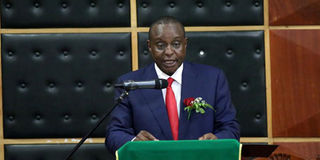A fifth of Kenya's budget committed to repaying loans

National Treasury Cabinet Secretary Henry Rotich reading the 2015/2016 Budget in the National Assembly on June 11, 2015. As at the beginning of the current financial year, Kenya’s debt was the highest in the region, at Sh3.2 trillion, with more than 60 per cent of it being domestic. FILE PHOTO | | NATION MEDIA GROUP
What you need to know:
The World Bank was particularly concerned by the rapid rise in borrowing from Beijing with the loans said to be coming at a heightened cost to the taxpayer.
The country proposes to spend Sh466 billion on public debt repayments in the financial year starting next month, effectively committing a fifth of the budget to repay loans.
As at the beginning of the current financial year, Kenya’s debt was the highest in the region, at Sh3.2 trillion, with more than 60 per cent of it being domestic.
Kenya’s soaring debt levels may present further distress to tax collection, which fell Sh69 billion below target for the nine months to March 2016.
The country proposes to spend Sh466 billion on public debt repayments in the financial year starting next month, effectively committing a fifth of the budget to repay loans.
The World Bank was particularly concerned by the rapid rise in borrowing from Beijing with the loans said to be coming at a heightened cost to the taxpayer.
“Kenya still has a heavy debt burden and China’s loans can bring debt to unsustainable levels,” the bank warns in a policy research working paper titled Deal or No Deal, Strictly Business for China in Kenya.
It says that some of China’s loans are non-concessional, which can raise debt-to-GDP levels quickly.
“As of June 30, 2015, Kenya’s gross public debt-to-GDP ratio was 49.7 per cent, and external loans contributed to the Sh420.9 billion increase in public debt from June 2014. China is already Kenya’s top source of external financing,” the bank’s experts said in the March report.
DOMESTIC DEBT
As at the beginning of the current financial year, Kenya’s debt was the highest in the region, at Sh3.2 trillion, with more than 60 per cent of it being domestic.
In the budget summary for the 2016/17 financial year submitted to Parliament by the National Treasury Cabinet Secretary Henry Rotich, Kenya is proposing that out of its Sh215 billion going to principal repayment, Sh172 billion or 79 per cent will be spent on domestic debt, with the remainder settling foreign debt.
Of the Sh251 billion marked for interest, Sh197 billion will go towards settling the domestic debt and the rest for foreign debt.
The repayment of interest on existing debt is worryingly in excess of the repayment of principal by 16.2 per cent.
With the taxman reeling behind a missed revenue collection target, the country, which spent close to 40.9 per cent of its tax revenues to settle its debts in the first nine months of the 2015/16 financial year might raise this portion with the debt levels having risen considerably.
At over 50 per cent public debt to GDP ratio, Kenya has surpassed the public debt which is above the 45 per cent Treasury threshold and so is the overall fiscal deficit, which stands at eight per cent against a target of below five per cent.
Last week as the IMF urged Kenya to lower her budget deficit for her debt to remain at manageable levels, Kenya was securing yet another loan of Sh153 billion to safeguard her from external shocks, adding to her mountain of debt.
“The Kenyan Government aims at lowering the budget deficit by three percentage points during the two years of IMF supporting programme. We think that is a wise course of action,” said IMF First Deputy Director David Lipton.
DEBT YARDSTICK
Generally, government debt as a percentage of GDP is used by investors to measure a country ability to make future payments on its debt, thus affecting the country borrowing costs and government bond yield.
A low debt-to-GDP ratio indicates an economy is producing a large number of goods and services and that brings in enough profit to pay back debts.
Alarm over rising debt began in 2013, when Parliament raised the debt ceiling from Sh800 billion to Sh1.2 trillion.
A year later, MPs further pushed it to Sh2.5 trillion, raising more concern from analysts and the Opposition that government borrowing was becoming unsustainable.
Kenya, which requires at least Sh6 trillion to fund mega projects, including the Sh327 billion standard gauge railway, Lamu Port South Sudan Ethiopia Transport project, generation of 5,000MW of power, the Galana Irrigation Scheme and the crude oil pipeline from Turkana to Lamu, may need to tread cautiously, though the debt levels remain.
Treasury CS Henry Rotich last year attributed the growth of external debt to the floating of an international sovereign bond worth Sh176 billion.





